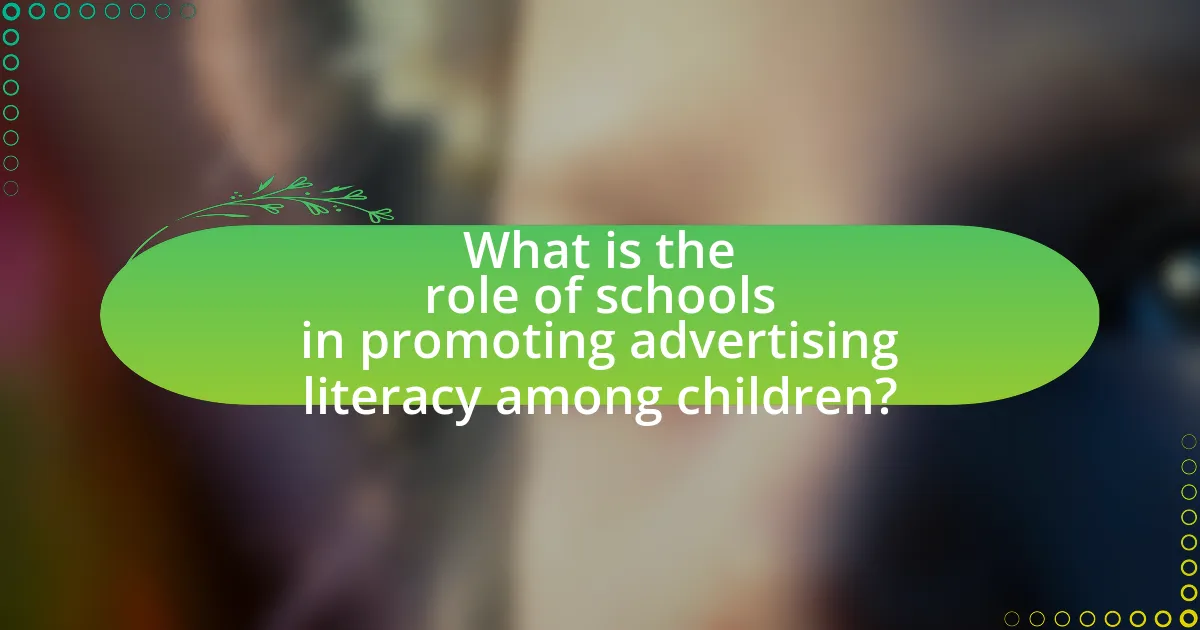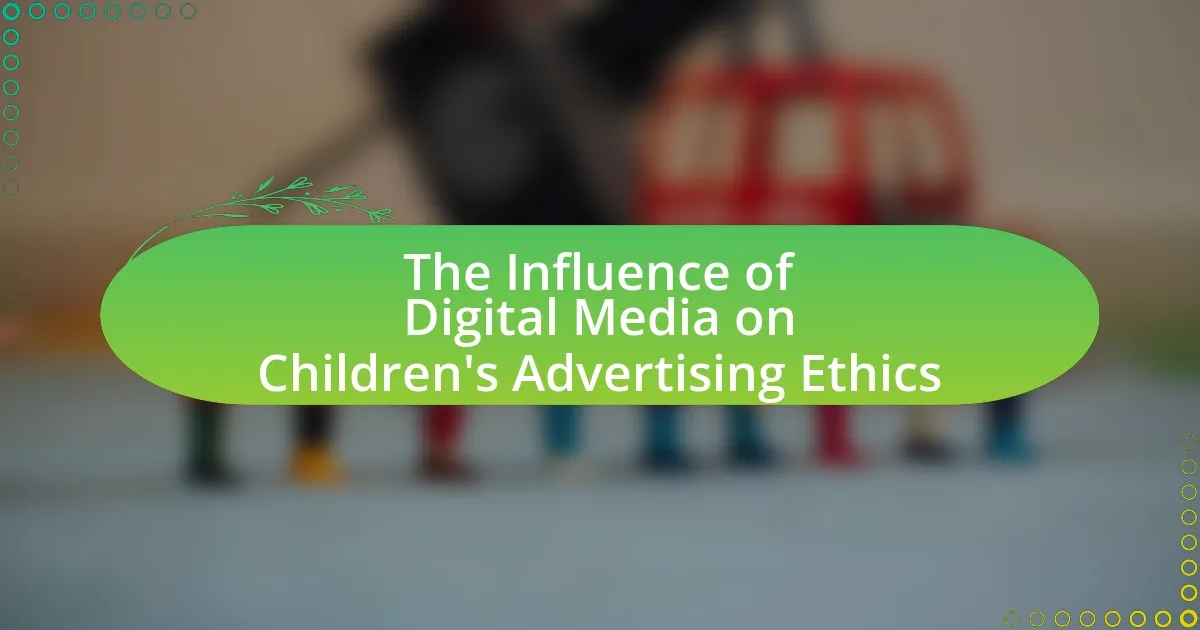The article examines the critical role of schools in promoting advertising literacy among children, emphasizing the integration of media education into curricula. It highlights the importance of advertising literacy in enabling children to analyze advertisements, understand persuasive techniques, and make informed consumer choices. The article discusses current educational practices, challenges faced by schools, and effective strategies for teaching advertising literacy, including the use of real-world examples and hands-on activities. Additionally, it explores the impact of societal attitudes and technological advancements on advertising literacy education, underscoring the need for comprehensive resources and teacher training to enhance students’ critical thinking skills in a media-saturated environment.

What is the role of schools in promoting advertising literacy among children?
Schools play a crucial role in promoting advertising literacy among children by integrating media education into their curricula. This integration helps students critically analyze advertisements, understand persuasive techniques, and recognize the influence of marketing on their choices. Research indicates that educational programs focused on media literacy can significantly enhance children’s ability to discern advertising intent and evaluate the credibility of information presented in ads. For instance, a study by the Center for Media Literacy found that students exposed to media literacy education demonstrated improved critical thinking skills regarding advertisements. By fostering these skills, schools empower children to navigate a media-saturated environment effectively.
Why is advertising literacy important for children?
Advertising literacy is important for children because it equips them with the skills to critically analyze and understand advertisements, enabling them to make informed decisions. As children are exposed to a significant amount of advertising, often estimated at over 40,000 ads per year, they need to discern persuasive techniques and recognize the intent behind marketing messages. Research indicates that children who possess advertising literacy are better able to identify misleading claims and develop healthier consumption habits, ultimately fostering critical thinking skills that are essential for navigating a media-saturated environment.
What are the potential impacts of advertising on children’s perceptions?
Advertising significantly influences children’s perceptions by shaping their understanding of products, brands, and societal norms. Children exposed to advertising often develop preferences for specific brands and products, which can lead to materialistic attitudes and unrealistic expectations about lifestyle and consumption. Research indicates that children as young as two can recognize brand logos, and by age eight, they can differentiate between advertising and programming, suggesting that advertising impacts their cognitive development and consumer behavior. A study published in the Journal of Consumer Research found that children who view more advertisements tend to exhibit higher levels of brand loyalty and preference, demonstrating the powerful role advertising plays in their formative years.
How can advertising literacy empower children in their consumer choices?
Advertising literacy empowers children in their consumer choices by equipping them with the skills to critically analyze advertisements and understand marketing strategies. This understanding enables children to discern persuasive techniques, such as emotional appeals and misleading claims, allowing them to make informed decisions about products and services. Research indicates that children who receive education on advertising literacy demonstrate improved critical thinking skills and are less susceptible to manipulative marketing tactics, as shown in studies conducted by the American Psychological Association, which highlight the effectiveness of educational programs in enhancing children’s ability to evaluate advertisements.
How do schools currently address advertising literacy?
Schools currently address advertising literacy through integrated curricula that focus on critical thinking and media analysis. Many educational institutions incorporate lessons on advertising techniques, persuasive language, and the impact of advertisements on consumer behavior, often using real-world examples to enhance understanding. Research indicates that programs like the “Media Literacy Now” initiative have been implemented in various states, promoting standards for media literacy education, which includes advertising literacy. These programs aim to equip students with the skills to critically evaluate advertisements and understand their influence, thereby fostering informed consumer behavior.
What subjects or programs incorporate advertising literacy in the curriculum?
Subjects and programs that incorporate advertising literacy in the curriculum include Media Studies, Communication Studies, and Consumer Education. These subjects focus on teaching students how to critically analyze advertisements, understand marketing techniques, and recognize persuasive messaging. For instance, Media Studies often includes modules on advertising analysis, while Consumer Education emphasizes informed decision-making regarding purchases influenced by advertising. Research indicates that integrating advertising literacy into these subjects enhances students’ ability to navigate media messages effectively, fostering critical thinking skills essential for understanding the commercial landscape.
How do teachers perceive their role in teaching advertising literacy?
Teachers perceive their role in teaching advertising literacy as crucial for equipping students with critical thinking skills necessary to navigate media messages. They recognize that understanding advertising is essential for fostering informed consumers who can discern persuasive techniques and evaluate the credibility of information. Research indicates that teachers often feel responsible for integrating advertising literacy into their curricula to help students analyze and question the motives behind advertisements, thereby promoting media literacy as a fundamental component of education.
What challenges do schools face in promoting advertising literacy?
Schools face several challenges in promoting advertising literacy, primarily due to limited resources, varying levels of teacher expertise, and the pervasive nature of advertising in students’ lives. Limited resources hinder the development of comprehensive curricula and training programs, making it difficult for educators to effectively teach advertising literacy. Additionally, teachers may lack the necessary training or confidence to address advertising concepts, leading to inconsistent instruction across different classrooms. The omnipresence of advertising in digital and traditional media further complicates the issue, as students are constantly exposed to persuasive messages, making it challenging for schools to create a focused learning environment. These factors collectively impede the effective promotion of advertising literacy among children.
What resources are lacking for effective advertising literacy education?
Effective advertising literacy education lacks comprehensive curriculum materials, trained educators, and accessible resources tailored to diverse learning needs. Comprehensive curriculum materials are essential for providing structured learning experiences, yet many schools do not have standardized programs that address advertising literacy. Additionally, trained educators who understand the nuances of advertising and its impact on children are often in short supply, limiting the effectiveness of instruction. Furthermore, accessible resources, such as interactive tools and real-world examples, are necessary to engage students but are frequently unavailable or underutilized in educational settings. These gaps hinder the ability of schools to effectively promote advertising literacy among children.
How do societal attitudes towards advertising influence school programs?
Societal attitudes towards advertising significantly influence school programs by shaping the curriculum and educational initiatives focused on advertising literacy. When communities view advertising as a critical skill for navigating consumer culture, schools are more likely to integrate advertising education into their programs, emphasizing critical thinking and media literacy. For instance, a study by the American Psychological Association found that children exposed to advertising literacy programs demonstrated improved analytical skills regarding media messages. This indicates that positive societal attitudes can lead to enhanced educational frameworks that prepare students to critically assess advertising content.
How can schools enhance their efforts in promoting advertising literacy?
Schools can enhance their efforts in promoting advertising literacy by integrating comprehensive media literacy programs into their curricula. These programs should focus on teaching students how to critically analyze advertisements, understand persuasive techniques, and recognize biases in media. Research indicates that media literacy education can significantly improve students’ ability to discern advertising strategies, as evidenced by a study published in the Journal of Advertising Research, which found that students exposed to media literacy training demonstrated a 30% increase in their ability to identify persuasive tactics in advertisements. By implementing such programs, schools can equip students with essential skills to navigate the complex advertising landscape effectively.
What strategies can educators implement to teach advertising literacy effectively?
Educators can implement strategies such as critical analysis of advertisements, integration of media literacy into the curriculum, and hands-on projects to teach advertising literacy effectively. Critical analysis involves guiding students to deconstruct advertisements, examining techniques like emotional appeal and persuasive language, which enhances their understanding of advertising tactics. Integrating media literacy into subjects like language arts or social studies allows students to explore the impact of advertising on society and consumer behavior. Hands-on projects, such as creating their own advertisements, enable students to apply their knowledge practically, fostering creativity and critical thinking. Research indicates that these strategies not only improve students’ analytical skills but also empower them to make informed decisions as consumers, as highlighted in the study “Media Literacy: A National Priority for a Changing World” by the National Association for Media Literacy Education.
How can partnerships with parents and communities support advertising literacy initiatives?
Partnerships with parents and communities can significantly enhance advertising literacy initiatives by fostering collaborative environments that promote critical thinking about media messages. When parents engage in discussions about advertising with their children, they reinforce the skills learned in schools, creating a consistent message that encourages children to analyze and question advertisements. Community organizations can provide resources, workshops, and real-world examples that further enrich the educational experience, making advertising literacy more relevant and applicable. Research indicates that children who receive support from both parents and community programs demonstrate improved understanding of advertising techniques and their persuasive intent, leading to more informed consumers.
What are the best practices for teaching advertising literacy in schools?
The best practices for teaching advertising literacy in schools include integrating critical thinking skills, using real-world examples, and fostering discussions about media content. Critical thinking skills enable students to analyze and evaluate advertisements effectively, helping them discern persuasive techniques. Utilizing real-world examples, such as current advertisements, allows students to apply their learning in a relevant context. Additionally, fostering discussions encourages students to express their thoughts and challenge assumptions about advertising, promoting a deeper understanding of its impact. Research indicates that programs incorporating these practices significantly enhance students’ ability to critically assess advertising messages (Harrison, 2020, Journal of Advertising Education).
What types of activities engage children in learning about advertising?
Activities that engage children in learning about advertising include creating their own advertisements, analyzing existing ads, and participating in role-playing exercises. These hands-on activities allow children to understand the persuasive techniques used in advertising, such as emotional appeal and target audience identification. For instance, a study by the American Psychological Association found that children who engage in creating advertisements demonstrate a better understanding of advertising strategies and their effects on consumer behavior. Additionally, analyzing ads helps children critically evaluate the messages conveyed, fostering media literacy skills essential for navigating today’s advertising landscape.
How can assessment methods be designed to evaluate advertising literacy?
Assessment methods can be designed to evaluate advertising literacy by incorporating a combination of formative and summative assessments that focus on critical thinking, media analysis, and practical application. These methods can include quizzes that test knowledge of advertising techniques, projects that require students to create their own advertisements while analyzing target audiences, and discussions that encourage critical evaluation of existing advertisements. Research indicates that hands-on activities, such as analyzing real-world ads and discussing their persuasive strategies, significantly enhance students’ understanding of advertising literacy. For example, a study by the American Psychological Association found that students who engaged in active learning strategies demonstrated a 30% increase in their ability to critically analyze advertisements compared to those who did not.
What resources are available for schools to promote advertising literacy?
Schools can utilize various resources to promote advertising literacy, including curriculum guides, online platforms, and community partnerships. For instance, organizations like the Center for Media Literacy provide comprehensive curriculum resources that help educators teach students how to critically analyze advertisements. Additionally, the Ad Council offers educational materials and campaigns aimed at enhancing media literacy among youth. Research indicates that integrating these resources into classroom instruction can significantly improve students’ ability to understand and critique advertising messages, thereby fostering informed consumers.
Which organizations provide support and materials for advertising literacy education?
Organizations that provide support and materials for advertising literacy education include the Center for Media Literacy, the American Academy of Pediatrics, and the National Association for Media Literacy Education. The Center for Media Literacy offers resources and training focused on critical thinking about media messages, while the American Academy of Pediatrics emphasizes the importance of media literacy in child development. The National Association for Media Literacy Education provides guidelines and educational materials aimed at enhancing media literacy skills among students. These organizations contribute significantly to the promotion of advertising literacy in educational settings.
How can schools access training for teachers on advertising literacy?
Schools can access training for teachers on advertising literacy through professional development programs offered by educational organizations and partnerships with media literacy initiatives. These programs often provide resources, workshops, and online courses specifically designed to enhance teachers’ understanding of advertising techniques and their impact on children. For instance, organizations like the Center for Media Literacy and the Media Literacy Now initiative offer structured training that equips educators with the necessary skills to teach advertising literacy effectively. Additionally, many universities and educational institutions provide courses focused on media literacy that can be integrated into teacher training programs, ensuring that educators are well-prepared to address the complexities of advertising in the classroom.
What future trends may influence advertising literacy education in schools?
Future trends that may influence advertising literacy education in schools include the increasing integration of digital media in curricula and the rise of social media platforms as primary sources of information for students. As digital media becomes more prevalent, schools will need to adapt their teaching methods to address the complexities of online advertising, including targeted ads and influencer marketing. Research indicates that children are exposed to an average of 4,000 ads per day, highlighting the necessity for educational programs that equip students with critical thinking skills to analyze and understand advertising messages. Additionally, the growing emphasis on media literacy in educational standards, such as the Common Core State Standards, supports the incorporation of advertising literacy into broader media education initiatives.
How might digital media change the landscape of advertising literacy?
Digital media may significantly enhance advertising literacy by providing interactive and diverse platforms for learning. These platforms allow children to engage with advertisements in real-time, fostering critical thinking and analytical skills as they navigate various media formats. Research indicates that exposure to digital content can improve understanding of advertising techniques, as children can analyze and discuss ads in a more dynamic context compared to traditional media. For instance, a study by the American Psychological Association found that children who interacted with digital advertisements demonstrated a higher ability to identify persuasive techniques than those exposed to static ads. This shift towards digital media creates opportunities for schools to integrate advertising literacy into their curricula, equipping students with essential skills to critically evaluate marketing messages in an increasingly digital world.
What role will technology play in enhancing advertising literacy programs?
Technology will play a crucial role in enhancing advertising literacy programs by providing interactive and engaging learning tools. Digital platforms can facilitate access to diverse educational resources, such as videos, games, and simulations that illustrate advertising techniques and strategies. For instance, studies show that using multimedia content increases retention rates among students, making them more aware of advertising tactics. Furthermore, technology enables real-time analysis of advertising trends and consumer behavior, allowing educators to tailor lessons to current market dynamics, thereby improving the relevance and effectiveness of advertising literacy education.
What practical steps can schools take to improve advertising literacy among children?
Schools can improve advertising literacy among children by integrating media literacy programs into the curriculum. These programs should focus on teaching students how to critically analyze advertisements, understand persuasive techniques, and recognize the intent behind marketing messages. Research indicates that media literacy education enhances critical thinking skills and empowers students to make informed decisions regarding advertising (Hobbs, 2010, “Digital and Media Literacy: A Plan of Action,” Aspen Institute). Additionally, schools can organize workshops and interactive activities that involve analyzing real advertisements, allowing students to apply their learning in practical scenarios. By fostering discussions around advertising ethics and the impact of advertising on society, schools can further deepen students’ understanding of the subject.





